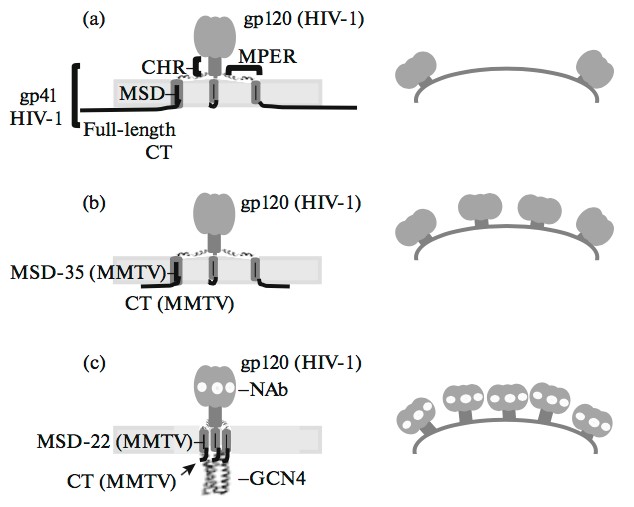Mempro™ Virus Families for Virus-like Particles (VLPs)
Virus-like particles (VLPs) are well known as empty shells of virus without genome. VLPs share the same virion structural properties without the ability to replicate, which made VLPs to be considered as the efficient and safe candidate for vaccine platforms and delivery systems. As several VLP-based vaccines have been approved in recent years, the application value of VLPs becomes more acceptable and shows more potentials in a broad range of areas.
Creative Biostructure has focused on VLPs research for years, and has established the advanced Mempro™ Virus-like Particles (VLPs) platform to provide various services from VLPs design & production to VLPs characterization. Our high-quality VLPs products are derived from various virus families including HBV, HIV, HCV, and NoV, etc.
 Figure 1. Modification of HIV-1 for more effective VLP vaccine production. (Molecular Biology, 2016)
Figure 1. Modification of HIV-1 for more effective VLP vaccine production. (Molecular Biology, 2016)
• Mempro™ Virus-like Particles (VLPs) for HBV
HBV (Hepatitis B virus) belongs to the virus family Hepadnaviridae. HBV is a remakable virus that had infected more than two billion people and becomes a truly global disease burden. VLP-based vaccine for HBV is the first successful case to apply VLPs technology to vaccine production. Creative Biostructure is interested in novel development of VLPs for HBV, and we provide custom VLPs production for HBV with our advanced yeast cells expression system.
• Mempro™ Virus-like Particles (VLPs) for HIV
HIV (human immunodeficiency virus) belongs to the virus family Retroviridae. HIV can infect crucial cells in the human immune system and lead to AIDS (acquired immunodeficiency syndrome). Creative Biostructure can design and produce the HIV-1 VLPs using our Mempro™ Virus-like Particles (VLPs) Production in Mammalian Cells System.
• Mempro™ Virus-like Particles (VLPs) for HPV
HPV is a DNA virus from the papillomavirus family, it contains approximate 150 members and each virus is given a number called its HPV type. It is different from HIV and HSV (herpes), indeed, it is so common that almost all sexually active women and men get it at one point in their lives. There are a number of different types of HPV, some can cause genital warts while some lead to cancers, especially cervical cancer.
• Mempro™ Virus-like Particles (VLPs) for Polyomaviruses
Polyomaviruses are abroad spread viruses in nature which were recognized as a virus family in 2006. They are small nonenveloped DNA viruses and remain latent after primary infection in immunocompetent hosts. In addition, several polyomaviruses are connected with human disease, even a number of them are oncoviruses which enable to cause tumors.
• Mempro™ Virus-like Particles (VLPs) for Adeno-associated Virus (AAV)
AAV is a small virus which has not known to cause disease so far, its hosts are humans and several other primate species. The immune response caused by AAV is quite mild, and it is obviously lack of pathogenicity. Using AAV for gene therapy vectors not only can infect dividing cells but also quiescent cells, moreover it can stay in an extrachromosomal condition without integrating into the genome of the host cells. With these special features, AAV has become an indeed magnetic candidate for the production of isogenic human disease models, and for inventing viral vectors for gene therapy.
• Mempro™ Virus-like Particles (VLPs) for Bacteriophage Qβ
Bacteriophage Qβ is one of the members of leviviridae family, and it has a 4.2 kb sense strand RNA genome encircled by the icosahedral capsid which is composed of 180 coat protein subunits. The virus is one of the diminutive RNA bacteriophages infecting Escherichia coli. There are four groups (I, II, III and IV) of bacteriophages and bacteriophage Qβ is regarded as group III due to its molecular biology.
We provide Mempro™ Virus-like Particles (VLPs) services for various virus families, also including Influenza A virus, HPV, Polyomaviruses, and Bacteriophage Qβ, etc. Please feel free to contact us for a detailed quote.
References:
A. N. Vzorov, et al. (2016). VLP Vaccines and Effects of HIV-1 Env Protein Modifications on their Antigenic Properties. Molecular Biology, 50(3): 406–415.
K. Roose, et al. (2014) Hepatitis B core–based virus–like particles to present heterologous epitopes. Expert Review of Vaccines, 12(2): 183-198.
L. X. Doan, et al. (2005). Virus-like particles as HIV-1 vaccines. Rev. Med. Virol., 15(2):75-88.
L. Huhti, et al. (2013). Characterization and immunogenicity of norovirus capsid-derived virus-like particles purified by anion exchange chromatography. Arch. Virol., 158:933–942.